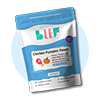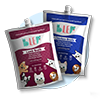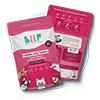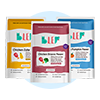Simply put, kibbles for dogs are small, pellet-shaped, dry food made with dried meat, grains, vegetables, and added supplements. They are usually sold in bulk packets, and marketed as convenient, nutritious, and shelf-stable.
In reality, they are packed with fillers, preservatives, starch, chemicals, and artificial additives. Even the meats, vegetables, grains used in kibbles are often of inferior quality or are byproducts, having little to no nutritional value. Whatever nutritional value they have is then further lost because of chemical treatment, processing, and cooking at high temperatures (between 100°C to 200°C). Artificial flavours and artificial nutrients are then added to it to make kibble more palatable and give it some nutrition.
Unfortunately, due to the artificial nature of the nutrients and the already-present fillers, preservatives, and chemicals, kibbles’ negative impact far outweighs its nutritional value, making it unsuitable for pets.

The History of Kibbles
The idea of processed dog food emerged from the most unlikely of places — at a port in Liverpool. Sailors and migrants who got off at the port were throwing hard, mouldy biscuits at stray dogs, which they were gobbling up. This was witnessed by James Spratt of Cincinnati, Ohio, who then made a kind of biscuit made with wheat, beet root, vegetables, and beef blood. This was given the name of Patent Meat Fibrine Dog Cakes by Spratt and became popular.
In 1922, the Chappel Brothers from Rockford, Illinois, introduced canned dog meat to the market. After World War I, with the rise in mechanical transportation, horses became a viable source of meat, and the Chappel Brothers used horse meat for their canned dog food. Canned dog food flew off the shelves and became the norm for pet food. On the other hand, with the Great Depression looming over the world in the 1930s, dog owners started looking for cheaper ways to feed their pets, thus adding fillers like grains and cereal products to dog food. In 1943, dehydrated dog food appeared and, being shelf-stable and lightweight, it was cost effective for both pet owners and manufacturers.
Processed dog food rose further in popularity during World War II due to shortage of tin. After the war, the demand kept increasing with support from mill operators, grain dealers, and meat packaging establishments, because it was easy for them to sell off their waste products as pet food ingredients rather than disposing them off.
In the 1950s, the “extrusion” process of making kibble was invented by Purina, in which all the ingredients were mixed up to form a hot, liquid food that was pushed through a machine and aerated. Then, it was baked and cut into pellet-like pieces. A lot of starch was needed in the food for the process to work, and it was baked twice in high temperatures, under immense pressure. Therefore, nutrients were mostly lost. So, manufacturers started spraying the pellets with added vitamins and minerals to add back some nutrition and also to make it more palatable. This process is still widely used today. Kibble was easy to store and cheaper, so it became widely accepted as the universal pet food.
Are Kibbles for Dogs Healthy?
For decades, dog food companies had us believe that processed, dry dog food was the most nutritious way of feeding dogs while home food, marketed as “table scraps”, was unhealthy. In the 1960s, the Pet Food Institute (PFI), a Washington-based lobbying association, helped get the idea further solidified in the minds of the consumers using newspaper articles, magazine features, as well as radio talk shows.
However, the truth is, kibbles are not a nutritionally-sound food for dogs. Here are a few reasons why —
-
The ingredients used in kibbles are often sub-par. This means that the meat used may be byproducts, discarded parts, spoilt meat, or even roadkill. The vegetables used may be old, rejected, or otherwise unfit as food. These have little nutritional value.
-
The sub-par ingredients are liquified, heated up, and processed through extrusion, which destroys what little nutritional value they had to begin with. Adding starch is also an essential part of the extrusion process.
-
Fillers, additives, and chemicals are then added either as preservatives, flavour enhancers, or supplements, which can pose serious danger to dogs.
Therefore, processed dry food or kibbles for dogs posits more health risks than health benefits. The starch can cause excessive weight gain, the origin of many fatal diseases. The chemicals and preservatives can also weaken immunity and cause gut issues, further hampering dogs’ health.

The Health Concerns Related to Kibbles for Dogs
Obesity: The artificially-added fats and sugars in kibble causes rapid increase in weight in dogs, making them overweight or obese. Obesity is just as dangerous in dogs as in humans, with the excess weight causing problems for internal organs, hormones, as well as bones and joints.
Diabetes: The starch in kibbles has a bad effect on almost every part of the body, and also causes diabetes in dogs. The effect of such sugar-filled food is so dangerous, that there has been a 850% rise in canine diabetes between 2011 and 2016, according to a UK-based study.
Allergies: Kibbles have a number of mystery ingredients as well as additives that can be toxic to dogs. These may sometimes trigger sensitivities and allergic reactions. Because of bulk packaging and supposed long shelf lives, kibbles for dogs may also become loaded with storage mites that trigger allergies.
Digestive Problems: The over-all composition of kibbles for dogs is not conducive to a healthy gut. Plus, the chemicals and preservatives also affect digestion as dog bodies are not naturally accustomed to such additives. Gut issues can disrupt absorption of nutrients and ruin health in a systemic way.
Dental Issues: The process of binding the ingredients of kibble together so it holds the pellet-like structure involves adding a lot of starch, and that’s nothing but sugar. This quickly builds up in the mouth of dogs and can cause teeth decay and gum problems.
Cancer: Kibbles are full of chemicals and preservatives to keep the food from going bad as well as to kill mould, bacteria, and other microorganisms. Many of them can cause serious health issues in dogs and lead to certain kinds of cancers. In fact, nearly 1 in 2 dogs aged ten and above will likely develop cancer and lifestyle contributes greatly to this.
What Are The Alternatives to Kibbles for Dogs?
Dogs need a balanced, nutritious diet. They need about 2.2 times their body weight in protein and calories from healthy sources, such as eggs, fish, liver, pumpkin, carrots, sweet potatoes, berries, bananas and such. Apart from that, other essential nutrients are also important, such as vitamins, minerals, fibre, and antioxidants. Natural, human-grade food made from quality ingredients is the alternative to kibbles for dogs.
This is where BLEP comes in. BLEP makes 100% natural food for dogs, which has zero preservatives, sugar, or chemicals. BLEP’s Natural Food is packed with protein, BLEP Bone Broths are rich in collagen, and BLEP’s Chicken Jerkies are a nutritious, starch-free way to treat your pups. Sealed packs of BLEP dog food also have a shelf life of 12 months from the date of manufacturing, making it both nutritious and convenient.

Looking to explore more healthy treats and care tips for your furry friend? Check out our other guides like Can Dogs Eat Apples?, Can Dogs Eat Blueberries?, Why Do Dogs Licks You?, Can Dogs Eat Strawberries?, Can dogs Eat Mango?, Dog Food for Weight Loss, Raw v/s cooked meat for dogs, Home Remedies to cure tick fever, Common Skin Problems in Dogs, Finding Good Dog Food in India, How many times should I feed my dog?, Things you should do to keep your pet healthy, Types of Dog Food, and How Prebiotics and Probiotics can improve your dog's digestion. Each guide is designed to help you make better food choices for your dog because the right diet is what gives you a happy and thriving pup.
Resources:












